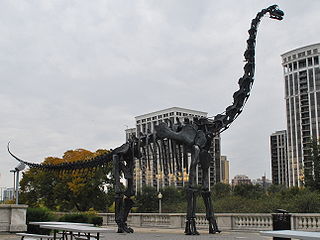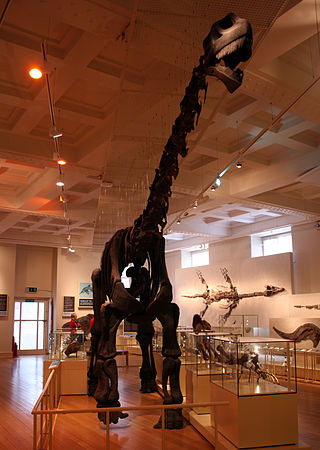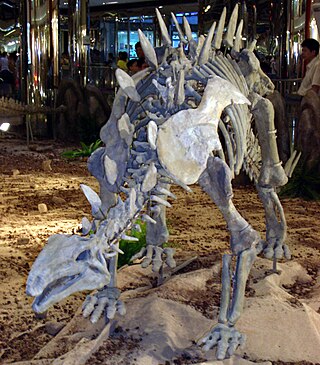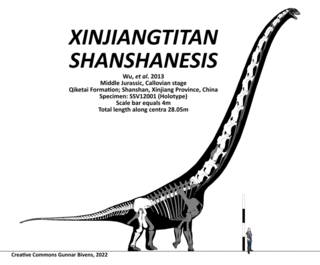
Sauroposeidon is a genus of sauropod dinosaur known from several incomplete specimens including a bone bed and fossilized trackways that have been found in the U.S. states of Oklahoma, Wyoming, and Texas.
Jobaria is a genus of sauropod dinosaur that lived in what is now Niger during the middle Jurassic Period, between 164 and 161 million years ago. Jobaria is currently the only known valid sauropod from the Tiouraren, where it was discovered in 1997.

The Brachiosauridae are a family or clade of herbivorous, quadrupedal sauropod dinosaurs. Brachiosaurids had long necks that enabled them to access the leaves of tall trees that other sauropods would have been unable to reach. In addition, they possessed thick spoon-shaped teeth which helped them to consume tough plants more efficiently than other sauropods. They have also been characterized by a few unique traits or synapomorphies; dorsal vertebrae with 'rod-like' transverse processes and an ischium with an abbreviated pubic peduncle.
Xiaosaurus, is a genus of small herbivorous dinosaur from the middle Jurassic, approximately 169 to 163.5 mya. Xiaosaurus lived in what is now the Sichuan Basin of China.

Cetiosaurus meaning 'whale lizard', from the Greek keteios/κήτειος meaning 'sea monster' and sauros/σαυρος meaning 'lizard', is a genus of herbivorous sauropod dinosaur from the Middle Jurassic Period, living about 168 million years ago in what is now Britain.

Giraffatitan is a genus of sauropod dinosaur that lived during the late Jurassic Period in what is now Lindi Region, Tanzania. It was originally named as an African species of Brachiosaurus (B. brancai), but this has since been moved to its own genus. Giraffatitan was for many decades known as the largest dinosaur but recent discoveries of several larger dinosaurs prove otherwise; giant titanosaurians appear to have surpassed Giraffatitan in terms of sheer mass. Also, the sauropod dinosaur Sauroposeidon is estimated to be taller and possibly heavier than Giraffatitan.

Huayangosaurus is a genus of stegosaurian dinosaur from the Middle Jurassic of China. The name derives from "Huayang" (華陽), an alternate name for Sichuan, and "saurus", meaning "lizard". It lived during the Bathonian to Callovian stages, around 165 million years ago, some 20 million years before its famous relative, Stegosaurus appeared in North America. At only approximately 4 metres (13 ft) long, it was also much smaller than its famous cousin. Found in the Lower Shaximiao Formation, Huayangosaurus shared the local Middle Jurassic landscape with the sauropods Shunosaurus, Datousaurus, Omeisaurus and Protognathosaurus, the ornithopod Xiaosaurus and the carnivorous Gasosaurus.

Tazoudasaurus is a genus of gravisaurian, probably a vulcanodontid sauropod dinosaurs hailing from the late Early Jurassic (Toarcian), that was recovered in the "Toundoute Continental Series" located in the High Atlas Mountains of Morocco in North Africa. Along with Patagosaurus, Volkheimeria, Bagualia and Perijasaurus represents one of the few sauropods named from this stage on Gondwana, as well the only one from Africa.

Huabeisaurus was a genus of dinosaur from the Late Cretaceous. It was a sauropod which lived in what is present-day northern China. The type species, Huabeisaurus allocotus, was first described by Pang Qiqing and Cheng Zhengwu in 2000. Huabeisaurus is known from numerous remains found in the 1990s, which include teeth, partial limbs and vertebrae. Due to its relative completeness, Huabeisaurus represents a significant taxon for understanding sauropod evolution in Asia. Huabeisaurus comes from Kangdailiang and Houyu, Zhaojiagou Town, Tianzhen County, Shanxi province, China. The holotype was found in the unnamed upper member of the Huiquanpu Formation, which is Late Cretaceous (?Cenomanian–?Campanian) in age based on ostracods, charophytes, and fission-track dating.

Tehuelchesaurus is a genus of dinosaur. It is named in honor of the Tehuelche people, native to the Argentinian province of Chubut, where it was first found.

Lapparentosaurus is a genus of sauropod dinosaur from the Middle Jurassic. Its fossils were found in Madagascar. The type species is L. madagascariensis.

Lusotitan is a genus of herbivorous brachiosaurid sauropod dinosaur from the Late Jurassic Period of Portugal.

Klamelisaurus is a genus of herbivorous sauropod dinosaur from the Middle Jurassic Shishugou Formation of China. The type species is Klamelisaurus gobiensis, which was named by Zhao Xijin in 1993, based on a partial skeleton discovered in 1982 near the abandoned town of Jiangjunmiao. Zhao described Klamelisaurus as the only member of a new subfamily, Klamelisaurinae, among the now-defunct primitive sauropod order Bothrosauropodoidea. Since Zhao's description, Klamelisaurus received limited attention from researchers until Andrew Moore and colleagues redescribed it in 2020.
Breviparopus is the name given to an ichnogenus of dinosaur, having been made by an unknown genus of sauropod. As an ichnogenus, the taxon is represented by a 90-metre (295 ft) long series of fossil tracks, or ichnites, found in the spring of 1979 in the Atlas Mountains of present-day Morocco. At the time, this area would have been part of the splitting Gondwana supercontinent. The animal that produced the Breviparopus tracks is rumored to be one of the largest dinosaurs, though its exact size has been the subject of much debate.

Brachiosaurus is a genus of sauropod dinosaur that lived in North America during the Late Jurassic, about 154 to 150 million years ago. It was first described by American paleontologist Elmer S. Riggs in 1903 from fossils found in the Colorado River valley in western Colorado, United States. Riggs named the dinosaur Brachiosaurus altithorax; the generic name is Greek for "arm lizard", in reference to its proportionately long arms, and the specific name means "deep chest". Brachiosaurus is estimated to have been between 18 and 22 meters long; body mass estimates of the subadult holotype specimen range from 28.3 to 46.9 metric tons. It had a disproportionately long neck, small skull, and large overall size, all of which are typical for sauropods. Atypically, Brachiosaurus had longer forelimbs than hindlimbs, which resulted in a steeply inclined trunk, and a proportionally shorter tail.

Spinophorosaurus is a genus of sauropod dinosaur that lived in what is now Niger during the Middle Jurassic period. The first two specimens were excavated in the 2000s by German and Spanish teams under difficult conditions. The skeletons were brought to Europe and digitally replicated, making Spinophorosaurus the first sauropod to have its skeleton 3D printed, and were to be returned to Niger in the future. Together, the two specimens represented most of the skeleton of the genus, and one of the most completely known basal sauropods of its time and place. The first skeleton was made the holotype specimen of the new genus and species Spinophorosaurus nigerensis in 2009; the generic name refers to what was initially thought to be spiked osteoderms, and the specific name refers to where it was found. A juvenile sauropod from the same area was later assigned to the genus.

Xinjiangtitan is an extinct genus of mamenchisaurid sauropod that lived during the Middle Jurassic of what is now Xinjiang, northwestern China. Its type and only species is Xinjiangtitan shanshanesis, known from a single incomplete skeleton recovered from the Qiketai Formation. The holotype preserves one of the most complete vertebral columns of any sauropod found in Asia, and has the longest complete neck known for any animal.

Vouivria is a genus of herbivorous sauropod dinosaur, belonging to the Brachiosauridae, that lived in the area of present France during the Late Jurassic. The type species is Vouivria damparisensis.

Mierasaurus is an extinct genus of sauropod dinosaur from the Early Cretaceous of Utah, United States. The taxon was first described and named in 2017 by Rafael Royo-Torres and colleagues, from a mostly complete skeleton including a disarticulated partial skull and mandible, teeth, multiple vertebrae from along the length of the body, both scapulae, radius and ulna bones, a left manus, a complete pelvis, both femora and the entire left hindlimb. Additionally, they referred a lower jaw and femur from juvenile individuals, which were found nearby, to the genus. Collectively, Mierasaurus is among the most completely known North American sauropods. The genus name honours Bernardo de Miera y Pacheco, the first European scientist to enter what is now Utah. The type species for Mierasaurus is Mierasaurus bobyoungi, named after Robert Glen Young, a paleontologist who researched the Early Cretaceous of Utah.

Spicomellus is an extinct genus of herbivorous ankylosaurian dinosaur that lived in the supercontinent Gondwana during the Middle Jurassic Period. The type and only known species is Spicomellus afer, named and described in 2021. Its remains were found in the third subunit of the El Mers Group (Bathonian-Callovian), near Boulahfa, south of Boulemane, Fès-Meknès, Morocco. The genus name means "spiked collar", from the Latin 'spica' meaning spike, and 'mellum' meaning spiked dog collar and the specific name 'afer' means "the African".






























